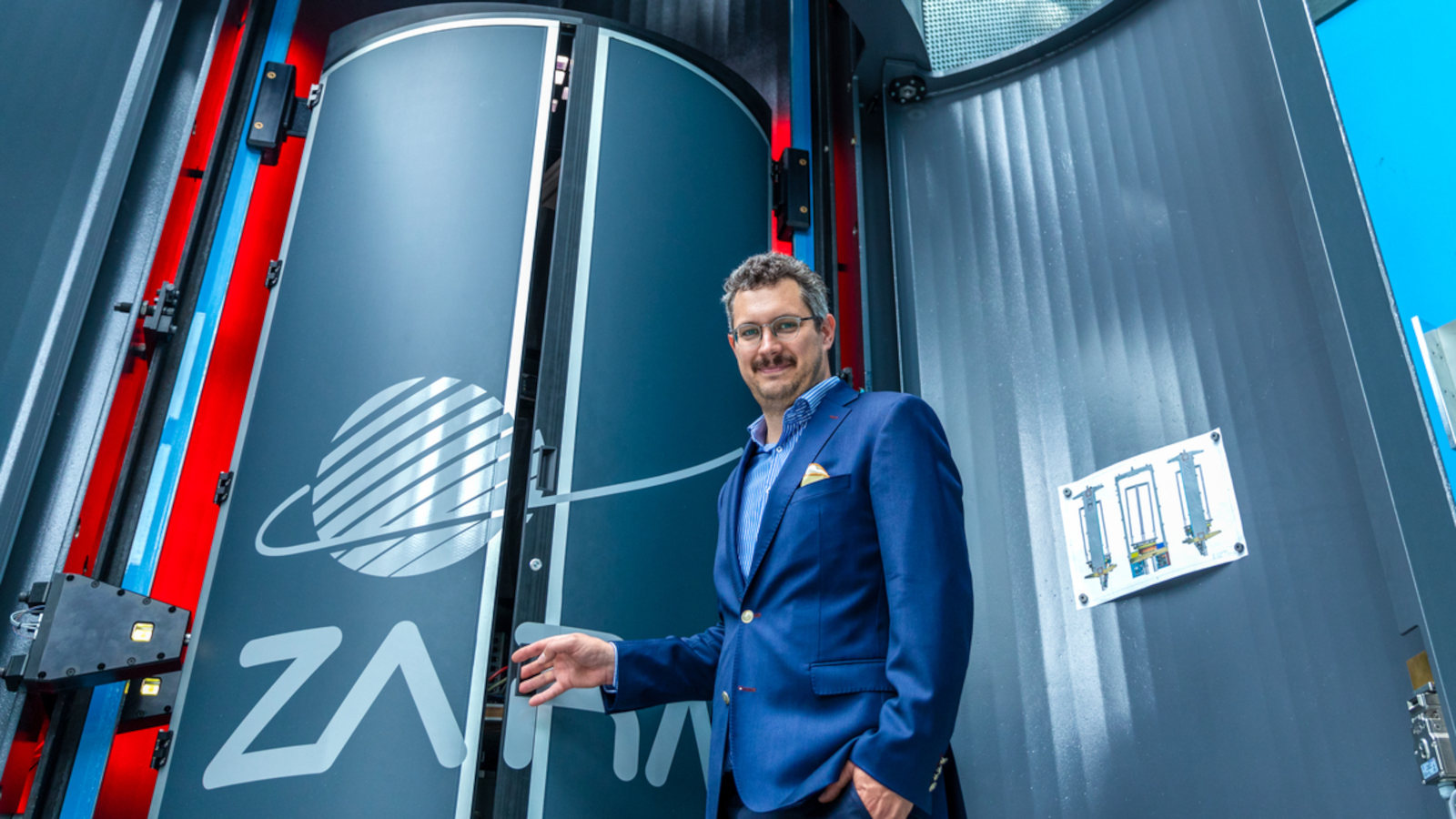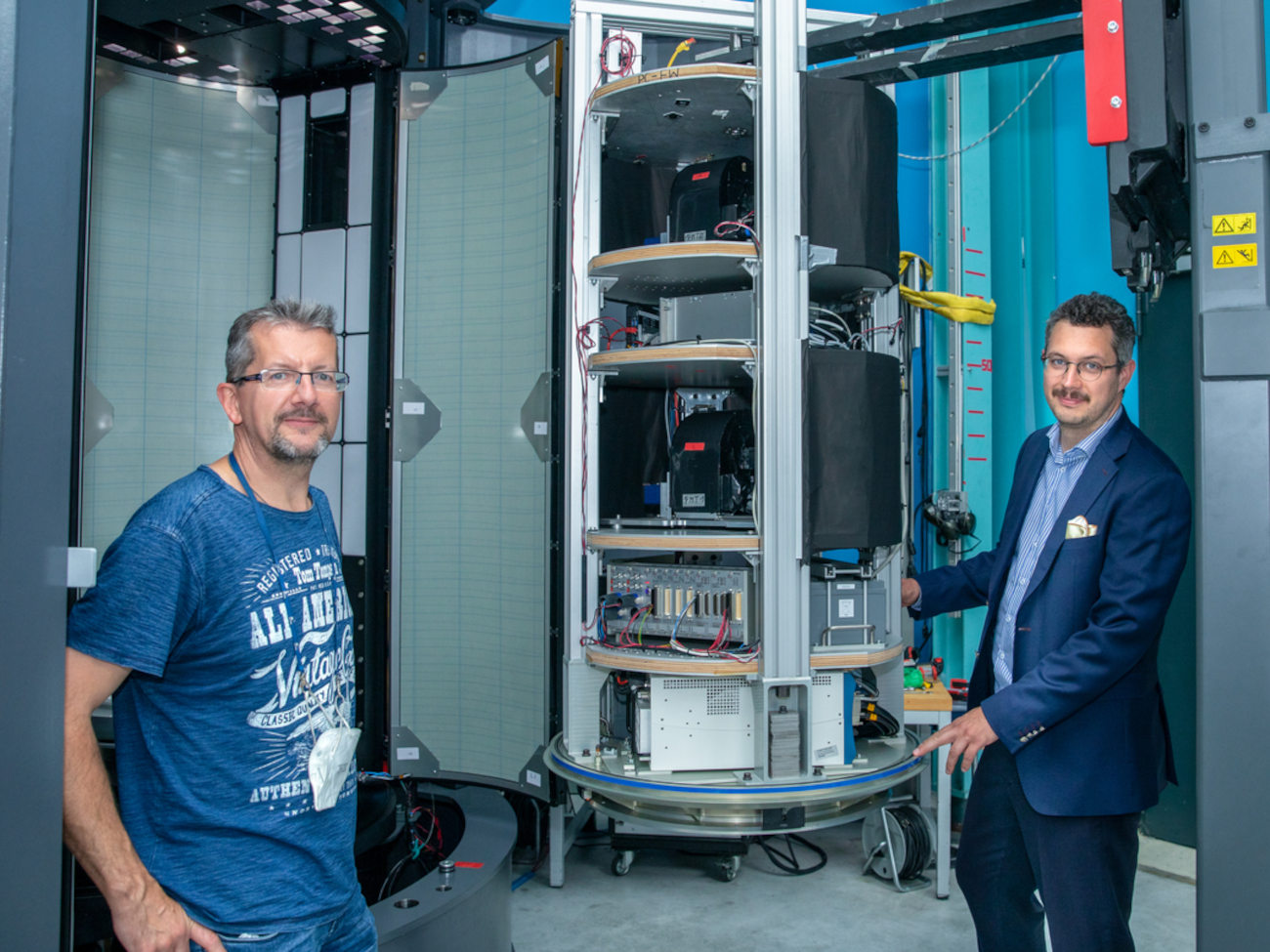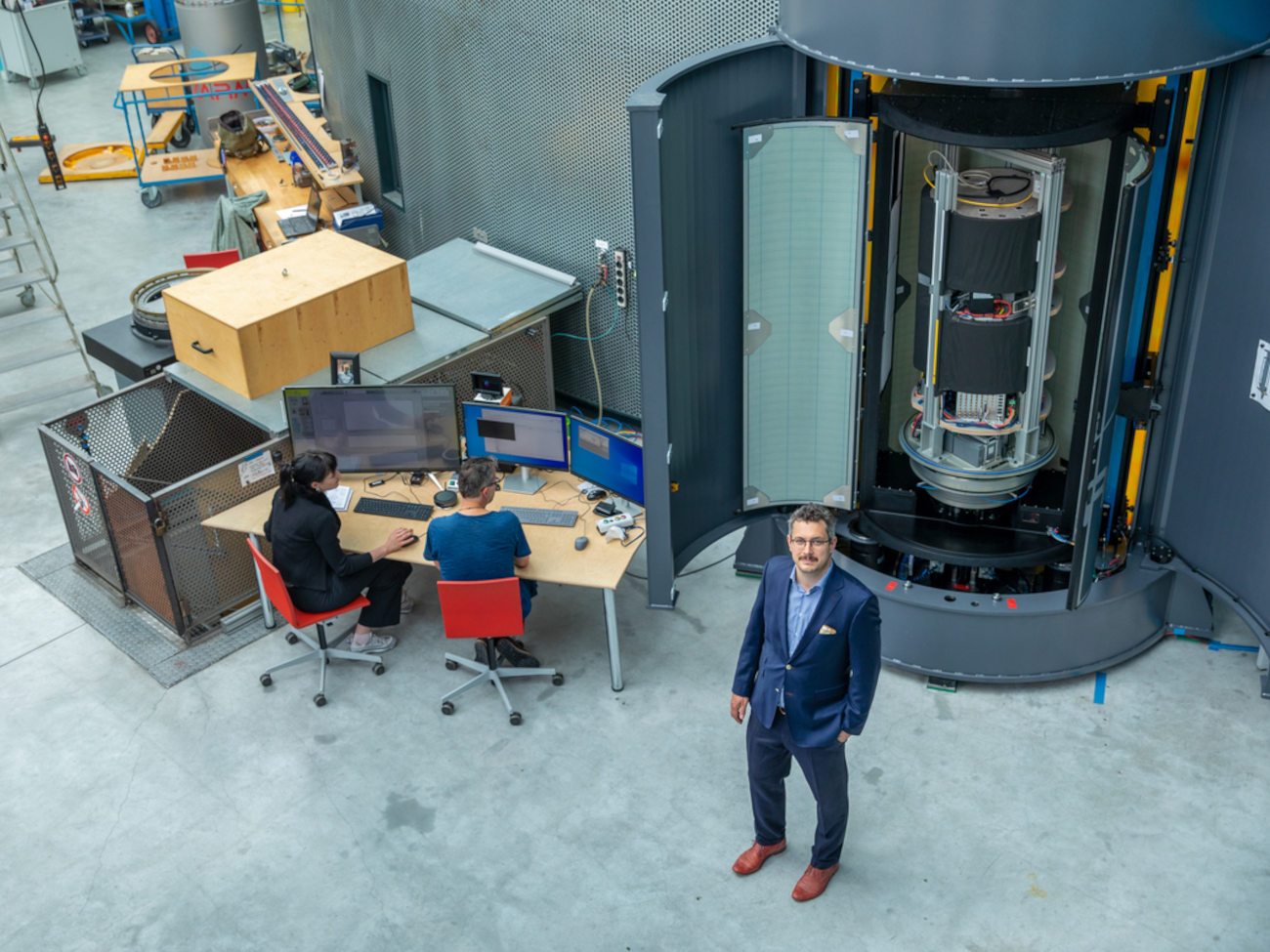
© Matej Meza / Universität Bremen
A Small Tower Doing Big Things
1.85 million euros invested to experience two and a half seconds of weightlessness: ZARM has put a new drop tower into operation.
You can see the big one, it has become a landmark of the city – we are talking about the University of Bremen’s Drop Tower. Now, a smaller version nestles up against it, and it also has a lot going for it. While only three flights a day are possible in the large drop tower, the new, faster drop tower can theoretically be used almost a thousand times in the same period.
Ten years ago, Dr. Andreas Gierse was still studying aircraft construction at Aachen University of Applied Sciences. At the time, he had no idea that he would one day design a state-of-the-art drop tower with sophisticated technology – even though he was already drawn to space technology. “I ultimately got in touch with the Center of Applied Space Technology and Microgravity (ZARM) at the University of Bremen through the REXUS program of the European Space Agency (ESA),” Gierse recalls. REXUS stands for “Rocket and Balloon Experiments for University Students” and is intended to introduce young people to space technology.
At that time, the drop tower at the University of Bremen had already existed for 22 years. It is a powerful and internationally recognized research platform that enables high-quality experiments with up to 9.3 seconds of weightlessness. The biggest limitation: only three flights per day are possible in the 146-meter-high tower. “We have to create a vacuum in the 120-meter drop tube each time before we shoot the experiment up by catapult and then drop it back down into a tub of Styrofoam balls. That takes time,” says Gierse. But weightlessness on Earth is still cheaper than in space, such as on the International Space Station (ISS). That’s why the large drop tower is already booked for experiments for more than a year in advance.
More Frequent and Simpler at High Quality
More frequent and simpler – and at a high quality. That was the challenge for Gierse when he joined ZARM. As project manager, he spent five years developing the technological heart of a faster drop tower: an elaborate decoupling mechanism. Together with his team, he first built a functional model of it. This convinced the ZARM FAB management to invest in the construction of the new laboratory, which then took another five years. Gierse wrote his doctoral thesis on this important component of the 16-meter-high tower, which is officially called “GraviTower Bremen Pro” (GTB). It is fair to say that the new research platform is “his baby.”

© Matej Meza / Universität Bremen
“Science, and thus the acquisition of knowledge, always takes place at the limits of what is known,” explains Andreas Gierse. “To obtain more meaningful results, you have to repeat experiments as often as possible – with different variables, under different conditions, using different approaches. The more repetitions, the more the picture sharpens.” To put it in perspective, an opinion survey with 300 participants is also much more meaningful than a survey with only three participants.
“The need for more flights has been around for a long time. Ten years ago, it was said that the number would have to be increased by at least a factor of 30 in order to get to the level of laboratory experiments with the experiments here.” So ideally 90 or 100 experiments in one day – that’s what the researchers wanted.
Today, that’s no longer a problem. “We can guarantee 300 flights a day, and we are still in the initial phase. Soon, we want to move toward 1,000,” says space expert Gierse. Aspects like automation and machine learning play an important role here. Artificial intelligence will help evaluate the huge amounts of data and control the experiments more precisely. Currently, ZARM employees are still on hand to help when researchers from all over Europe and beyond work with the GraviTower. Soon, however, the experiments will be able to run 24 hours a day without “human assistance.”
Sophisticated System Has Been Patented
It’s hard for the average person to imagine how it all works. If you look at the experimental setups, all you see is a great deal of electronics in a precisely designed environment, a few colorful lights reflecting the status of the experiment, and large screens showing settings and results. What’s important here is what’s going on in the new lab – and that no vacuum is needed for the experiments in it.
“No other drop tower in the world allows for such high-quality experiments at such a frequency.” Dr. Andreas Gierse, GraviTower project manager at ZARM
“Put very simply: We shoot the capsule up and drop it again,” Gierse explains. The hydraulics fire the sled with the experimental setup upward at five times the acceleration due to gravity, which takes less than a second. The space technician: “Despite the insane forces involved, there must be no vibrations applied to the experiment itself.” To achieve this, the experiment is effectively mechanically separated from the sled by the aforementioned centerpiece of the system during the acceleration phase and is completely “disengaged” after acceleration. It then floats in space without contact for two and a half seconds – with the capsule around it, which must move precisely along with it so that there is no contact with the experimental setup. This sequence is controlled in fractions of a second by lasers and distance sensors, among other things. It was part of Andreas Gierse’s PhD and is, of course, now patented.
“In these two and a half seconds, the experiment is weightless – just as we are for a brief moment when we jump into the air.” The experiment runs during that time. At the end of the weightless phase, the experiment setup is very gently coupled back to the sled by an additional system. It all sounds like a very big challenge to make complicated processes run extremely precisely at jet speed. And it is. It’s no coincidence that the entire project took so many years before it could be transferred to everyday research operations. “Other things in the new drop tower are also very special,” says Andreas Gierse. “For example, we developed the drive technology in collaboration with our partner Bosch-Rexroth. There, we also carried out elaborate simulations for two years until we came close to the real application that we use today.”

© Matej Meza / Universität Bremen
There is no doubt then that it is a technological marvel that has been newly created at the foot of the big drop tower. That is why ZARM is very proud of this development, which is currently unique in its form. “There are now a lot of smaller drop towers around the world. But none of them allow for such high-quality experiments at such a frequency,” says Gierse. The GTB is definitely another upgrade for Bremen as an aerospace location, he adds.
What Comes Next?
The project manager is already thinking ahead: “The facility works and is fully usable for scientific purposes. Everything is scalable – you could build a larger drop tower with this technology and then be able to offer weightlessness for a longer period of time. Right now, we have the opportunity to initiate a new era of Earth-based research under space conditions.” The interest from the scientific community is certainly present. Of course, this includes from ZARM itself, where they are also happily using the new on-site possibilities for their own research. So, another drop tower for Bremen – a medium-sized one, perhaps? Andreas Gierse laughs, “We’ll see …”
Mars Research on Campus? Researchers at ZARM do not only use the GraviTower Bremen Pro to conduct experiments in zero gravity – they can also use it to test how processes take place under gravitational conditions on Mars. Nearly a thousand times a day, for 2.5 seconds experiments can take place in to one-third of the Earth’s gravitational force, exactly as it exists on Mars. Moreover, experiments are possible in as little as one-sixth of the Earth’s gravity, which corresponds to conditions on the Moon, or in even lower gravitational environments, such as on asteroids.
The researchers behind the “Humans on Mars” initiative could also benefit from these research opportunities: In July 2022, the “Humans on Mars – Pathways toward a long-term sustainable exploration and settlement of Mars” initiative was established. In this project, around 60 scientists from eight faculties are investigating pathways toward a sustainable human exploration of Mars, funded by Bremen State. The impetus and leadership for Humans on Mars comes from the high-profile area of MAPEX Center for Materials and Processes at the University of Bremen. In addition, there is a close collaboration with independent research institutes belonging to the U Bremen Research Alliance.
Further information on the Humans on Mars initiative is available on the Website.